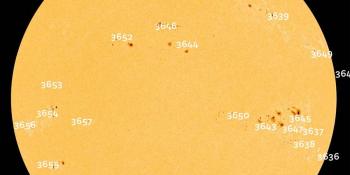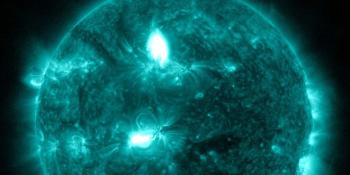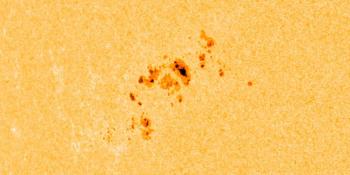Viewing archive of środa, 28 stycznia 2004
Raport aktywności słonecznej
Any mentioned solar flare in this report has a scaling factor applied by the Space Weather Prediction Center (SWPC). Because of the SWPC scaling factor, solar flares are reported as 42% smaller than for the science quality data. The scaling factor has been removed from our archived solar flare data to reflect the true physical units.
Raport aktywności słoneczno- geomagnetycznej 2004 Jan 28 2200 UTCPrzygotowane przez NOAA © SWPC i przetworzone przez SpaceWeatherLive.com
Połączenie raportów USAF/NOAA o słonecznej i geofizycznej aktywności
Numer SDF 028 wydany w 2200Z na 28 Jan 2004IA. Analiza aktywności regionów słonecznych i aktywność od 27-2100Z do 28-2100Z Solar activity was very low. There were no flares in
the past 24 hours. The solar disk was devoid of spots for most of
the day, but towards the end of the period there was evidence for a
new active region (or regions) rotating on the disk at latitudes
S10-S15, near the location where old Region 536 would be expected.
IB. Prognoza aktywności słonecznej
Solar activity is expected to be very
low. There should be a slow rise in background levels as the new
active region (or regions) rotate into view.
IIA. Podsumowanie aktywności geofizycznej 27-2100Z do 28-2100Z
The geomagnetic field ranged from unsettled to minor storm levels.
Solar wind velocity showed a gradual increase beginning around 0100
UTC, and this was accompanied by frequent fluctuations in the
interplanetary Bz component in the range of about -7 nT to +7 nT.
These signatures together with a consistent 'away' polarity in the
solar phi angle all suggest that the activity was driven by
favorably positioned positive polarity coronal hole. The greater
than 2 MeV electron fluxes were at high levels during the past 24
hours.
IIB. Prognoza aktywności geofizycznej
The geomagnetic field is
expected to be unsettled with occasional active periods for the next
two days (29-30 January). An increase to unsettled to active is
expected on the third day (31 January) as another coronal hole
rotates into favorable position.
III. Prawdopodobieństwa zdarzenia 29 Jan do 31 Jan
| Klasa M | 01% | 01% | 01% |
| Klasa X | 01% | 01% | 01% |
| Proton | 01% | 01% | 01% |
| PCAF | Green | ||
IV. Przepływ 10,7 cm z Penticton
Zaobserwowano 28 Jan 089 Przewidywane 29 Jan-31 Jan 100/105/105 Średnia z 90 dni 28 Jan 126
V. Indeks geomagnetyczny A
Zaobserwowano Afr/Ap 27 Jan 013/016 Szacowane Afr/Ap 28 Jan 015/019 Przewidywane Afr/Ap 29 Jan-31 Jan 010/015-010/015-010/020
VI. Prawdopodobieństwa aktywności geomagnetycznej 29 Jan do 31 Jan
| A. Średnie szerokości geograficzne | |||
|---|---|---|---|
| Aktywne | 25% | 25% | 25% |
| Słaba burza | 15% | 15% | 15% |
| Bardzo znacząca burza | 05% | 05% | 05% |
| B. Wysokie szerokości geograficzne | |||
|---|---|---|---|
| Aktywne | 30% | 30% | 30% |
| Słaba burza | 20% | 20% | 20% |
| Bardzo znacząca burza | 05% | 05% | 05% |
<< Idź do codziennego przeglądu
Najnowsze wiadomości
Najnowsze wiadomości z forum
AR 3637, 3638, 3643 87Unproven theories 341Space Weather Memes 338Filaments and prominences 55Growth of Cycle 25 433
Więcej tematówWesprzyj SpaceWeatherLive.com!
Wielu ludzi odwiedza SpaceWeatherLive aby śledzić aktywność słoneczną lub sprawdzić czy jest szansa na zaobserwowanie zorzy polarnej. Niestety, większy ruch na stronie oznacza większe koszty utrzymania serwera. Dlatego, jeśli jesteś zadowolony ze strony SpaceWeatherLive, zachęcamy do wspierania nas finansowo. Dzięki temu będziemy mogli utrzymać naszą stronę.

Fakty na temat pogody kosmicznej
| Ostatnie rozbłyski klasy X | 2024/03/28 | X1.1 |
| Ostatnie rozbłyski klasy M | 2024/04/24 | M2.0 |
| Ostatnia burza geomagnetyczna | 2024/04/19 | Kp7 (G3) |
| Spotless days | |
|---|---|
| Ostatni dzień bez skazy | 2022/06/08 |
| Monthly mean Sunspot Number | |
|---|---|
| marca 2024 | 104.9 -19.8 |
| Last 30 days | 133.9 +26.6 |


